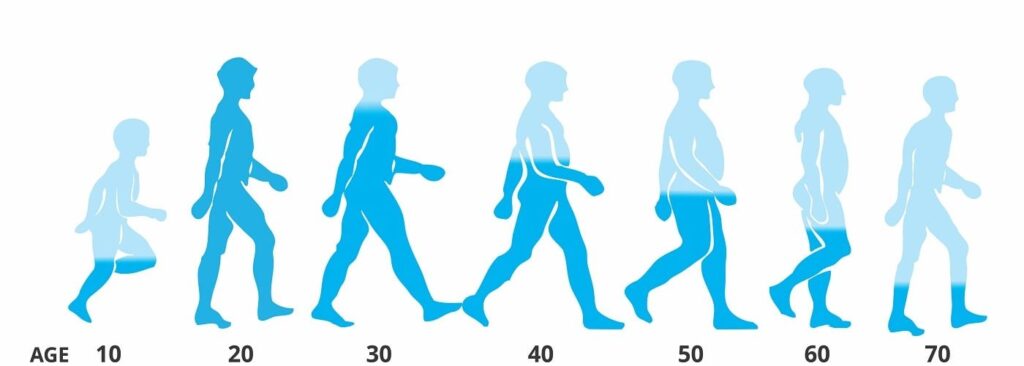
Testosterone is vital for both men and women, supporting energy, muscle strength, bone health, mood, and sexual function. Imbalances either too low or too high can affect physical and mental well-being, fertility, and long-term health, making early detection and proper management essential.
Key Takeaways
- Normal testosterone ranges: men 300–950 ng/dL; women 15–70 ng/dL, with levels declining with age.
- Low testosterone causes fatigue, mood decline, bone loss, low libido, and reduced muscle strength.
- Major causes include aging, obesity, chronic illness, medications, and hormonal disorders.
- Diagnosis requires morning blood tests for total/free testosterone, LH, FSH, and related hormones.
- Lifestyle measures exercise, balanced diet, quality sleep, and stress control improve hormone balance.
- TRT benefits men with confirmed low T but requires close medical supervision; it’s not FDA-approved for women.
Normal Testosterone Ranges by Sex and Age

Knowing what counts as a normal testosterone level helps people and their doctors decide when treatment is needed. Levels naturally decrease with age, but significant drops or rises are concerning.
In men, testosterone exists as total testosterone (all testosterone in blood) and free testosterone (unbound, active form). Free testosterone is a smaller amount but is what your body uses directly. Most labs measure total testosterone first.
| Age Group | Total Testosterone (ng/dL) | Free Testosterone (pg/mL) |
| 20-39 | 300–950 | 9–30 |
| 40-59 | 280–900 | 7–25 |
| 60+ | 250–850 | 5–20 |
Most doctors consider less than 300 ng/dL low in men, but symptoms must also be present.
In women, the normal range is much lower, and levels can vary by lab and age. There is no strict agreement on the cutoff, but generally:
| Age Group | Total Testosterone (ng/dL) |
| 20-49 | 15–70 |
| 50+ | 10–45 |
Symptoms are more important than numbers in women, especially after menopause or if ovaries are removed. Many factors, such as time of day and some illnesses, can temporarily affect levels. Morning blood tests are most reliable for men.
Causes of Low Testosterone
Low testosterone can happen for many reasons. Below is a simple table comparing causes in men and women. Recognizing the source can help target the best treatment.
| Cause Type | Men | Women |
| Primary | Testicular injury, surgery, aging | Ovarian failure, surgical ovary removal |
| Secondary | Pituitary gland problems, head injury | Pituitary or adrenal disease |
| Age-related | Natural decline after 30, steeper after 50 | Slow decline from 30s, faster after menopause |
| Chronic Disease | Diabetes, obesity, liver/kidney problems | Autoimmune, chronic illness, major weight loss |
| Medications | Opioids, steroids, chemotherapy, some antidepressants | Steroids, psychiatric drugs |
| Other | Heavy drinking, lack of exercise | Sudden weight loss or gain, severe stress |
Symptoms of Low Testosterone in Men and Women
Symptoms of low testosterone can vary but often affect multiple areas of life. Below is a clear table for easier comparison.
| Symptom Category | Men | Women |
| Sexual | Low libido, erectile dysfunction, fewer erections | Low libido, irregular periods, vaginal dryness |
| Physical | Loss of muscle, increased body fat, body hair loss, weak bones, breast swelling | Muscle weakness, bone loss, fatigue, hair thinning, dry skin |
| Mental | Fatigue, depression, poor memory, hot flashes | Low mood, poor focus, less energy |
| Other | Anemia, less sperm, small testicles | Infertility, lower exercise tolerance |
Diagnosing Low Testosterone
Testing for testosterone issues begins with a conversation about symptoms and a blood test. Here are the key steps:
- Doctors order a blood test in the morning, when testosterone peaks. Two tests on separate days are usually needed to confirm results.
- Both total and free testosterone can be measured. Total is the first step, but free is sometimes needed for a clear diagnosis.
- Additional blood tests may include LH (luteinizing hormone), FSH (follicle-stimulating hormone), prolactin, thyroid, and DHEA. These show if the problem starts in the brain, glands, or elsewhere.
- Imaging like MRI of the pituitary or ultrasound of ovaries/adrenals is considered if tumors, injuries, or major hormone imbalances are found.
Treatment Strategies for Low and High Testosterone
There are three main ways to address testosterone problems: lifestyle, medication, and treating underlying health issues. Starting with lifestyle is safest and often the most effective.
Lifestyle First
Healthy lifestyle habits can protect or even boost testosterone for many people.
- Eat a balanced diet, not an extreme low-fat plan. Good fats are important for hormone health.
- Regular exercise, especially strength training, helps maintain hormone balance.
- Sleep 7 to 8 hours nightly. Poor sleep can lower testosterone.
- Lose extra weight, especially belly fat. This can increase testosterone naturally.
Medical Options
Some people need more than lifestyle changes.
- For men: Testosterone Replacement Therapy (TRT) is available as injections, gels, or pellets. This can improve energy, mood, muscle, and sex drive. Clomiphene may be used if fertility is still wanted.
- For women: TRT is experimental and not FDA-approved. Some women use low-dose testosterone under close medical care for severe symptoms. The risks must be considered, especially for the heart and liver.
Treat Underlying Conditions
Improving health problems that affect hormones can help restore balance.
- Treat sleep apnea, diabetes, and thyroid problems.
- Manage obesity with healthy eating and activity.
What You Need to Remember
Testosterone imbalances can significantly affect overall health, especially as we age, but early recognition and proper management can greatly improve quality of life. Paying attention to changes in mood, energy, bone strength, and sexual health, and confirming concerns through lab tests, allows for timely treatment and prevention of serious complications. With the right combination of lifestyle changes, medical options, and ongoing follow-up with your doctor, most people can manage symptoms well and enjoy better well-being as they grow older.
Conclusion
Testosterone is essential for maintaining health and well-being in both men and women, particularly as we grow older. This hormone affects energy, mood, muscle and bone strength, sexual health, and even heart health. Common signs of imbalance such as fatigue, changes in mood, weak bones, or sexual problems should be taken seriously and not dismissed as just a part of aging. Fortunately, a straightforward blood test can identify hormone levels.
In many cases, healthy habits like good nutrition, regular exercise, and quality sleep can restore balance. If needed, medical therapies are available, but these should always be monitored by a healthcare provider to prevent side effects. Early detection and treatment can improve daily life, prevent long-term complications, and support overall vitality. Regular checkups and honest discussions with your doctor are key to staying active, independent, and healthy as you age.
Frequently Asked Questions (FAQs)
1. What is considered a low testosterone level in men and women?
For men, levels under 300 ng/dL with symptoms are usually low. For women, levels under 15 ng/dL are considered low, but symptoms matter more than the number.
2. Can low testosterone cause depression?
Yes, studies show low testosterone can affect mood, leading to depression and irritability in both men and women. Treating the hormone imbalance often improves these symptoms.
3. Is low T reversible without therapy?
In some cases, improving sleep, diet, exercise, or stopping certain medicines can boost testosterone naturally. It is not always possible, but lifestyle changes are the first step.
4. How is low testosterone treated in women?
There is no FDA-approved therapy, but some doctors use low-dose testosterone for severe symptoms. This requires close monitoring because risks and benefits are still being studied.
5. Can low-fat diets lower testosterone?
Very low-fat diets can reduce testosterone levels. A balanced diet with healthy fats is better for hormone health.
6. What are the side effects of TRT?
Side effects may include acne, swelling, sleep problems, breast changes, increased red blood cells, or prostate issues in men. Regular blood tests help catch problems early.
7. How often should testosterone levels be checked?
If you have symptoms, your doctor will usually check levels twice to confirm. If on treatment, follow-up tests are needed every 3 to 6 months or as advised.
8. Does low testosterone affect fertility?
Yes, in men, low testosterone can reduce sperm count. In women, it can affect ovulation, leading to irregular periods or infertility.
9. Can stress cause low testosterone?
Chronic stress can raise cortisol, which lowers testosterone. Managing stress with relaxation and good habits supports healthy hormone levels.
10. When is a pituitary scan needed?
A pituitary scan is needed if blood tests show very low testosterone with abnormal brain hormone levels, or if you have headaches or vision changes that may signal a brain gland problem.
References
- Cleveland Clinic: Low Testosterone (Male Hypogonadism)
- Wikipedia: Testosterone PMC+4Cleveland Clinic+4Reddit+4
- PMC (NIH): Circulating Testosterone & Sex Differences PMC
- ScienceDirect: Testosterone Clinical Cardiology Journal+5PMC+5Cleveland Clinic+5
- Medical News Today: Normal Testosterone Levels
- Mayo Clinic: Male Hypogonadism
- Healthline: Symptoms of Low Testosterone
- Harvard Health: Myths About Low Testosterone
- TIME: Women and Testosterone
- Verywell Health: Diagnosing Low Testosterone
- arXiv Preprint: Low-fat Diets and Testosterone arxiv.org
- Journal of Clinical Endocrinology & Metabolism: Testosterone Trial
- Cleveland Clinic: Low Testosterone in Women Cleveland Clinic
Dr. Ethan Ward, MD, is a board-certified urologist with over 12 years of clinical experience specializing in men’s health, hormone optimization, and sexual wellness. He earned his MD from Johns Hopkins University School of Medicine and completed his urology residency at Cleveland Clinic. Dr. Ward focuses on testosterone therapy, erectile function, and metabolic contributors to hormonal imbalance. His work includes peer-reviewed research on andropause management and patient-centered approaches to male vitality.


